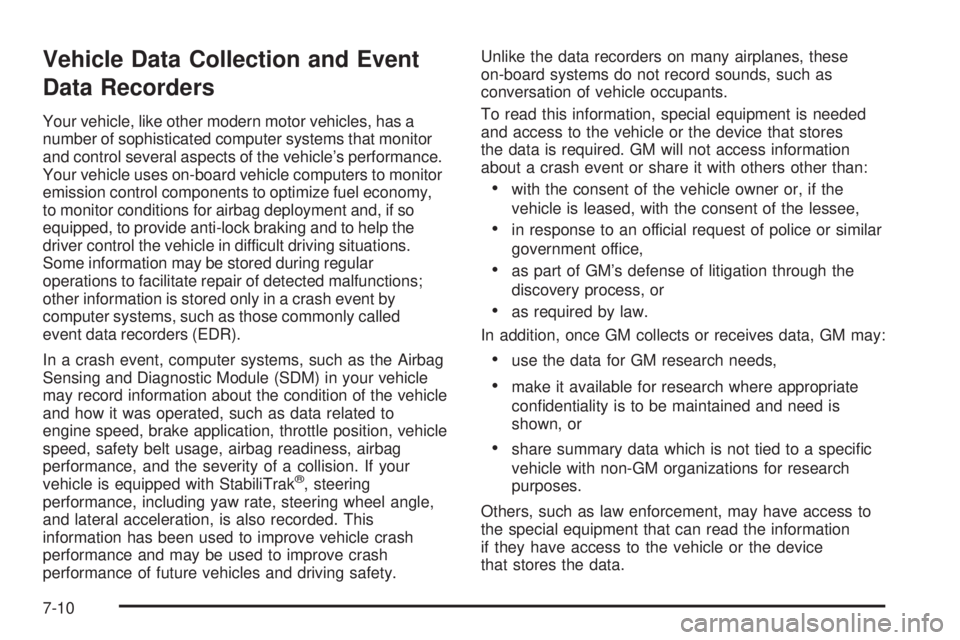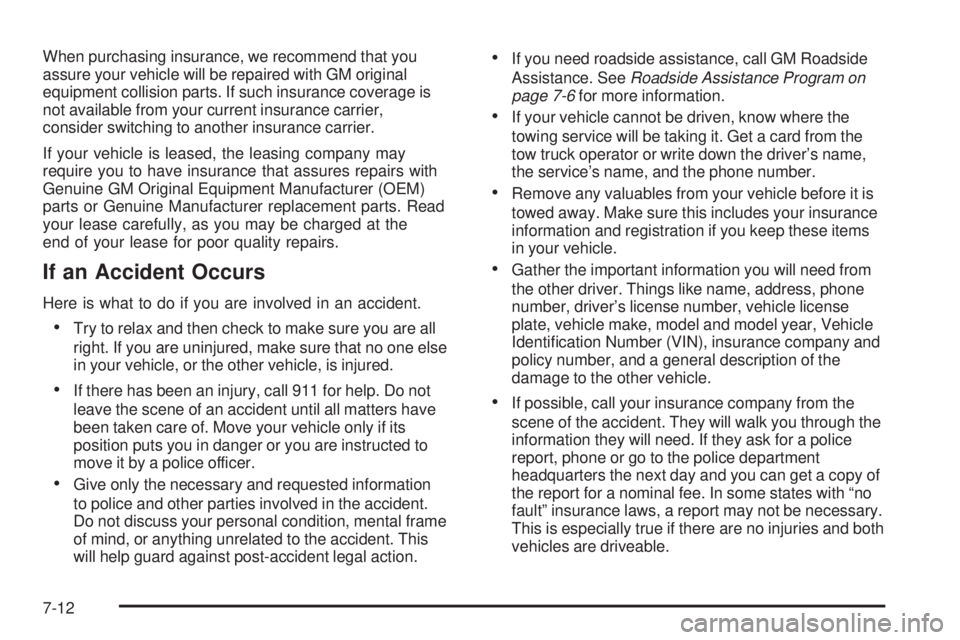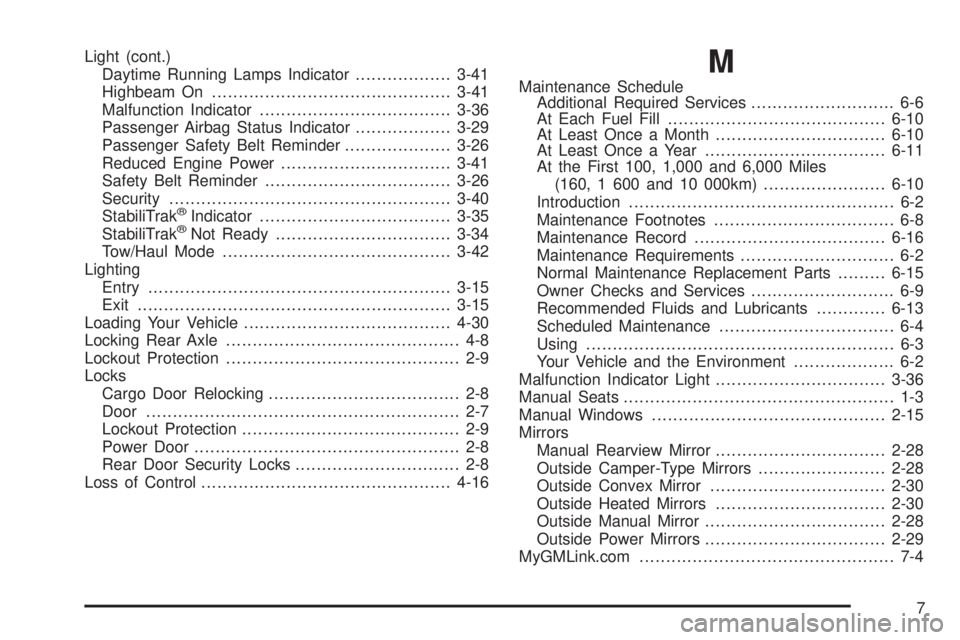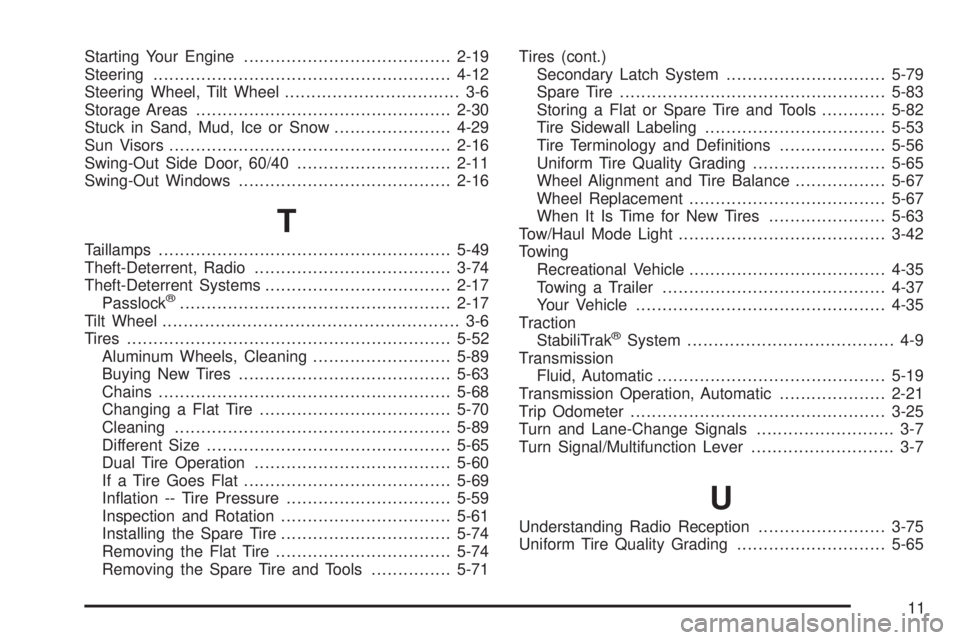ECO mode GMC SAVANA 2006 Owner's Guide
[x] Cancel search | Manufacturer: GMC, Model Year: 2006, Model line: SAVANA, Model: GMC SAVANA 2006Pages: 394, PDF Size: 2.56 MB
Page 376 of 394

Vehicle Data Collection and Event
Data Recorders
Your vehicle, like other modern motor vehicles, has a
number of sophisticated computer systems that monitor
and control several aspects of the vehicleās performance.
Your vehicle uses on-board vehicle computers to monitor
emission control components to optimize fuel economy,
to monitor conditions for airbag deployment and, if so
equipped, to provide anti-lock braking and to help the
driver control the vehicle in difficult driving situations.
Some information may be stored during regular
operations to facilitate repair of detected malfunctions;
other information is stored only in a crash event by
computer systems, such as those commonly called
event data recorders (EDR).
In a crash event, computer systems, such as the Airbag
Sensing and Diagnostic Module (SDM) in your vehicle
may record information about the condition of the vehicle
and how it was operated, such as data related to
engine speed, brake application, throttle position, vehicle
speed, safety belt usage, airbag readiness, airbag
performance, and the severity of a collision. If your
vehicle is equipped with StabiliTrak
Ā®, steering
performance, including yaw rate, steering wheel angle,
and lateral acceleration, is also recorded. This
information has been used to improve vehicle crash
performance and may be used to improve crash
performance of future vehicles and driving safety.Unlike the data recorders on many airplanes, these
on-board systems do not record sounds, such as
conversation of vehicle occupants.
To read this information, special equipment is needed
and access to the vehicle or the device that stores
the data is required. GM will not access information
about a crash event or share it with others other than:
ā¢with the consent of the vehicle owner or, if the
vehicle is leased, with the consent of the lessee,
ā¢in response to an official request of police or similar
government office,
ā¢as part of GMās defense of litigation through the
discovery process, or
ā¢as required by law.
In addition, once GM collects or receives data, GM may:
ā¢use the data for GM research needs,
ā¢make it available for research where appropriate
conļ¬dentiality is to be maintained and need is
shown, or
ā¢share summary data which is not tied to a speciļ¬c
vehicle with non-GM organizations for research
purposes.
Others, such as law enforcement, may have access to
the special equipment that can read the information
if they have access to the vehicle or the device
that stores the data.
7-10
Page 378 of 394

When purchasing insurance, we recommend that you
assure your vehicle will be repaired with GM original
equipment collision parts. If such insurance coverage is
not available from your current insurance carrier,
consider switching to another insurance carrier.
If your vehicle is leased, the leasing company may
require you to have insurance that assures repairs with
Genuine GM Original Equipment Manufacturer (OEM)
parts or Genuine Manufacturer replacement parts. Read
your lease carefully, as you may be charged at the
end of your lease for poor quality repairs.
If an Accident Occurs
Here is what to do if you are involved in an accident.
ā¢Try to relax and then check to make sure you are all
right. If you are uninjured, make sure that no one else
in your vehicle, or the other vehicle, is injured.
ā¢If there has been an injury, call 911 for help. Do not
leave the scene of an accident until all matters have
been taken care of. Move your vehicle only if its
position puts you in danger or you are instructed to
move it by a police officer.
ā¢Give only the necessary and requested information
to police and other parties involved in the accident.
Do not discuss your personal condition, mental frame
of mind, or anything unrelated to the accident. This
will help guard against post-accident legal action.
ā¢If you need roadside assistance, call GM Roadside
Assistance. SeeRoadside Assistance Program on
page 7-6for more information.
ā¢If your vehicle cannot be driven, know where the
towing service will be taking it. Get a card from the
tow truck operator or write down the driverās name,
the serviceās name, and the phone number.
ā¢Remove any valuables from your vehicle before it is
towed away. Make sure this includes your insurance
information and registration if you keep these items
in your vehicle.
ā¢Gather the important information you will need from
the other driver. Things like name, address, phone
number, driverās license number, vehicle license
plate, vehicle make, model and model year, Vehicle
Identiļ¬cation Number (VIN), insurance company and
policy number, and a general description of the
damage to the other vehicle.
ā¢If possible, call your insurance company from the
scene of the accident. They will walk you through the
information they will need. If they ask for a police
report, phone or go to the police department
headquarters the next day and you can get a copy of
the report for a nominal fee. In some states with āno
faultā insurance laws, a report may not be necessary.
This is especially true if there are no injuries and both
vehicles are driveable.
7-12
Page 389 of 394

Light (cont.)
Daytime Running Lamps Indicator..................3-41
Highbeam On.............................................3-41
Malfunction Indicator....................................3-36
Passenger Airbag Status Indicator..................3-29
Passenger Safety Belt Reminder....................3-26
Reduced Engine Power................................3-41
Safety Belt Reminder...................................3-26
Security.....................................................3-40
StabiliTrak
Ā®Indicator....................................3-35
StabiliTrakĀ®Not Ready.................................3-34
Tow/Haul Mode...........................................3-42
Lighting
Entry.........................................................3-15
Exit...........................................................3-15
Loading Your Vehicle.......................................4-30
Locking Rear Axle............................................ 4-8
Lockout Protection............................................ 2-9
Locks
Cargo Door Relocking.................................... 2-8
Door........................................................... 2-7
Lockout Protection......................................... 2-9
Power Door.................................................. 2-8
Rear Door Security Locks............................... 2-8
Loss of Control...............................................4-16
M
Maintenance Schedule
Additional Required Services........................... 6-6
At Each Fuel Fill.........................................6-10
At Least Once a Month................................6-10
At Least Once a Year..................................6-11
At the First 100, 1,000 and 6,000 Miles
(160, 1 600 and 10 000km).......................6-10
Introduction.................................................. 6-2
Maintenance Footnotes.................................. 6-8
Maintenance Record....................................6-16
Maintenance Requirements............................. 6-2
Normal Maintenance Replacement Parts.........6-15
Owner Checks and Services........................... 6-9
Recommended Fluids and Lubricants.............6-13
Scheduled Maintenance................................. 6-4
Using.......................................................... 6-3
Your Vehicle and the Environment................... 6-2
Malfunction Indicator Light................................3-36
Manual Seats................................................... 1-3
Manual Windows............................................2-15
Mirrors
Manual Rearview Mirror................................2-28
Outside Camper-Type Mirrors........................2-28
Outside Convex Mirror.................................2-30
Outside Heated Mirrors................................2-30
Outside Manual Mirror..................................2-28
Outside Power Mirrors..................................2-29
MyGMLink.com................................................ 7-4
7
Page 393 of 394

Starting Your Engine.......................................2-19
Steering........................................................4-12
Steering Wheel, Tilt Wheel................................. 3-6
Storage Areas................................................2-30
Stuck in Sand, Mud, Ice or Snow......................4-29
Sun Visors.....................................................2-16
Swing-Out Side Door, 60/40.............................2-11
Swing-Out Windows........................................2-16
T
Taillamps.......................................................5-49
Theft-Deterrent, Radio.....................................3-74
Theft-Deterrent Systems...................................2-17
Passlock
Ā®...................................................2-17
Tilt Wheel........................................................ 3-6
Tires.............................................................5-52
Aluminum Wheels, Cleaning..........................5-89
Buying New Tires........................................5-63
Chains.......................................................5-68
Changing a Flat Tire....................................5-70
Cleaning....................................................5-89
Different Size..............................................5-65
Dual Tire Operation.....................................5-60
If a Tire Goes Flat.......................................5-69
Inļ¬ation -- Tire Pressure...............................5-59
Inspection and Rotation................................5-61
Installing the Spare Tire................................5-74
Removing the Flat Tire.................................5-74
Removing the Spare Tire and Tools...............5-71Tires (cont.)
Secondary Latch System..............................5-79
Spare Tire..................................................5-83
Storing a Flat or Spare Tire and Tools............5-82
Tire Sidewall Labeling..................................5-53
Tire Terminology and Deļ¬nitions....................5-56
Uniform Tire Quality Grading.........................5-65
Wheel Alignment and Tire Balance.................5-67
Wheel Replacement.....................................5-67
When It Is Time for New Tires......................5-63
Tow/Haul Mode Light.......................................3-42
Towing
Recreational Vehicle.....................................4-35
Towing a Trailer..........................................4-37
Your Vehicle...............................................4-35
Traction
StabiliTrak
Ā®System....................................... 4-9
Transmission
Fluid, Automatic...........................................5-19
Transmission Operation, Automatic....................2-21
Trip Odometer................................................3-25
Turn and Lane-Change Signals.......................... 3-7
Turn Signal/Multifunction Lever........................... 3-7
U
Understanding Radio Reception........................3-75
Uniform Tire Quality Grading............................5-65
11